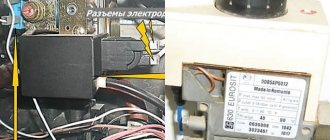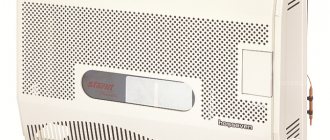Today, everyone is familiar with the situation when cold weather comes suddenly and a person is simply not ready for it. This issue remains relevant for everyone - both for residents of private households and for residents of multi-storey buildings.
In the first case, as a rule, a person simply did not have time to complete the house and is going to spend the winter in one or two furnished rooms, and in the second, utility services are in no hurry to supply heating to houses; during this period they are usually still busy repairing heating systems.
In all these cases, as well as in a number of others, temporary heating of the home would be a suitable option. An alternative source of heat in such situations is a catalytic heater.
A catalytic heater is a device whose operating principle involves the oxidation of fuel air with oxygen on the surface of a certain special catalyst.
The process of operation of the system can be characterized as combustion without flame and unnecessary noise. In everyday life they are often called air heaters.
Attention:
With catalytic combustion of fuel, in comparison with conventional flame combustion, the highest thermal output is observed. In addition, these devices allow you to obtain heat in an environmentally friendly and safe way for health.
All high-quality and reliable sources of temporary heating, regardless of the type of fuel they use, are endowed with one important advantage: They operate for a long period of time without special maintenance. All this indicates their high fire and explosion safety.
Gas catalytic heater
Gas - appearance.
A modern device designed for domestic use can fully heat with its power:
- country cottage;
- dacha;
- small workshop;
- warehouses;
- garage;
- any construction project and many others.
The fuel in a gas catalytic heater is propane-butane gas exclusively in liquefied form. The heating element here is a catalytic panel. It is made in most cases from fiberglass containing platinum powder.
Be careful when choosing!
The modern market offers the latest models of deep oxidation catalysts that do not contain platinum group metals.
Thanks to the catalyst, the gas combustion process occurs quite efficiently and at the same time the room is saturated with absolutely clean air. Models of such heaters are presented on the market today in various configurations, including those that make it possible to additionally use a heating element or an electric fan heater.
When using these devices, the maximum power of the gas heater itself is achieved; it can rise to a level of 4.9 kW.
Gasoline - general appearance
The gasoline type operates on the basis of gasoline vapors coming from the tank.
The fuel is poured into this very tank, after which it goes into the catalytic cartridge. In it, gasoline vapors are completely oxidized with atmospheric oxygen, that is, they burn without fire on the hot surface of the catalyst.
Special ventilation holes are used here to remove oxidation products that appear during processing. Through them, simultaneously with the removal of oxidation products, air containing oxygen enters the surface of the catalyst.
The catalyst is usually made in the form of a mesh, which is located inside a mesh cartridge made of steel and serves as a wick. In some models, the catalyst is made of platinum, and therefore it is the main component of the device itself.
The best option among catalytic heaters used in everyday life would be a catalytic heating pad. All lovers of an active lifestyle and, mainly, lovers of camping and multi-day trips are well aware of it.
Good to know:
The fuel for heaters of this type can only be gasoline that has the highest degree of purification.
Infrared - general appearance of the device
Many people have heard professionals in their circles use the serious term gas catalytic infrared heater.
In fact, here we are talking about the most ordinary infrared gas heater, which includes ceramic thermal panels that work on the principle of the sun.
To put it more simply, such a device does not heat the air itself, but those objects that are located near it, and they, in turn, give off heat to heat the room itself.
Basically, infrared gas heaters are used as an additional heating system in a room. However, sometimes they are used as the main heating element.
This device is advisable to use in large areas where the total square footage exceeds 20 meters.
Attention:
Do not use GMO to heat a room whose area is less than 10 square meters, such as a garage or small workshop, it may be unsafe.
A catalytic gas heater is a heating device in which thermal energy is generated as a result of catalytic (flameless) combustion of fuel.
Infrared or normal?
The heaters have thermal ceramic panels and reflectors that provide local targeted effects. The operating principle is based on the conversion of heat energy into infrared radiation. Such models can be used in the home or for heating outdoor areas. Infrared and catalytic heaters use gas as fuel. This provides good performance.
Household heaters that use liquid fuel or gas, but do not have infrared radiation, are also in great demand. Among such devices there is a fairly miniature device that is easy to carry with you, and there are also quite large installations, the dimensions of which resemble a large boiler. This device perfectly heats the air in the room. That is why, in order to increase productivity, the unit has a fan heater.
Research shows that infrared heaters using bottled gas are suitable for heating a room larger than 20 square meters. But such devices are not recommended for small rooms. Brands of catalytic heaters.
Catalytic combustion of fuel: what is it?
Catalytic combustion of fuel is the oxidation reaction of hydrocarbons in the presence of catalysts. Its main advantage is the absence of an open flame and the relatively low heating temperature of the contact surface, which is 150-200 C.
In essence, catalytic combustion makes it possible to obtain a low-temperature infrared heating device that emits heat in a wavelength range that is comfortable for humans.
The catalysts are usually platinum or palladium, the high cost of which has long been the main obstacle to the widespread use of catalytic combustion.
The result (product) of fuel combustion during a catalytic reaction is the same substances as during conventional fuel combustion - carbon dioxide and water, CO2 and H2O. However, the process occurs without excess oxygen, which is of great importance for maintaining comfortable conditions in the room in which the heating device is installed and used. In other words, the catalytic combustion process does not “burn out” the oxygen in the room.
Another advantage of catalytic combustion is the complete combustion of fuel to the final combustion products. The formation of an intermediate product of carbon monoxide is excluded.
Devices that generate heat during catalytic combustion of fuel have been known since the Second World War. They are small metal containers with holes for supplying air and removing combustion products, inside which there is a catalyst and cotton wool moistened with alcohol or gasoline. To start such a heater, it is necessary to heat the surface of the catalyst with an open flame and start the combustion process of alcohol vapor.
Then the flame is extinguished, and the process of heat release during the catalytic reaction of alcohol combustion continues. During the reaction, the surface of the heating pad heats up to 50-60 C, which allows you to wear it on your body under clothes, keeping you warm in severe frost.
Such heating pads are still widely used today during expeditions and hikes. It should be noted that high-quality alcohol or gasoline is used as fuel for camping heating pads, and the devices themselves are expensive equipment.
Catalytic reaction of fuel combustion for heating houses and apartments
The widespread use of catalytic combustion for heating homes became possible relatively recently, with the advent of a new technology for the production of a catalytic plate, which makes it possible to apply a microscopic layer of platinum to the surface of fiberglass, sufficient to initiate and maintain the catalytic combustion reaction.
Inexpensive, affordable catalyst has allowed for a broad view of catalytic combustion and its use in gas combustion.
However, the catalytic combustion reaction of hydrocarbons is demanding on the composition of the fuel used. The gas must first be purified from harmful impurities that contaminate the surface of the catalyst and reduce the efficiency of the device. But even these high requirements did not become an obstacle to the development of a new type of heating devices - catalytic gas heaters, which are of considerable interest to consumers.
Catalytic gas heaters
An example of a catalytic gas heater is a heating device from the Bartolini Pullover brand, running on LPG (bottled liquefied gas). The Bartolini Pullover heater is designed to heat one room.
Gas combustion in the heater occurs on a fiberglass mesh, on the surface of which a layer of platinum is applied. The gas cylinder is installed behind the burner. It should be noted that an LPG cylinder with a volume of 27 liters is supplied with the device and is its integral part. To ensure the safety of the combustion process, the device is equipped with a CO2 concentration sensor. When the level of concentration of combustion products increases, the device automatically turns off.
The main advantage of catalytic gas heaters is the ability to operate the device without using a chimney. However (in accordance with SNiP) when operating any gas equipment, it is necessary to ensure the removal of combustion products using a properly functioning chimney or ventilation system. The second prerequisite is the presence of a constant flow of fresh air.
You need to understand that the combustion process, whether catalytic or conventional, is a fuel oxidation reaction, in which oxygen necessarily participates, and during which carbon dioxide is necessarily produced, an increased concentration of which is dangerous to human health and life.
A catalytic gas heater, unlike other gas heaters, allows you to obtain low-temperature heat (150-200 C) that is more comfortable for humans. This is precisely its main advantage.
More and more consumers are interested in reserve heat resources in case it is not possible to use the main heating sources. A catalytic (gas or gasoline) heater is a progressive new product among heating devices that has gained popularity in Russia and Europe in a short period of time.
Catalytic heaters are devices that produce heat through oxidation
. To do this, a catalyst plate is located in the body of the device; when fuel enters it, a reaction occurs, resulting in the generation of heat.
Fuel consumption is carried out in a flameless manner. And this eliminates the formation of combustion products, which makes the device environmentally friendly and safe. In terms of efficiency, the heater outperformed a standard gas burner.
All of these factors explain the growing consumer confidence. Heating occurs according to the following scheme:
- The surface of the catalyst plate is heated from 200 to 500 0 C.
- The fuel-air liquid is heated in a separate chamber.
- Fumes from burning fuel fall on the hot fiberglass plate.
- Under the influence of a catalyst, a so-called flameless combustion reaction occurs.
In other words, the operation of the device is carried out due to the oxidation of combustion products
.
When fuel hits the catalyst plate, it interacts with it, oxidizes and produces a large amount of energy. Compared to the small size of the heater itself, the amount of heat it produces is impressive.
A standard catalytic device is capable of maintaining heat in a room with an area of 15 to 25 sq.m.
The plate will last about seven years
, after which it can be changed in special repair shops; there is no need to purchase a new device.
Oven “Bulleryan”
The Bulleryan stove is a technical invention that saves money and energy, made by energy engineers in Canada.
Different from other heaters, which only release heat from the outer surface, Bulleryan is designed from the very beginning as a true air heater.
The all-metal structure with numerous pipes welded into it ensures forced convection, resulting in rapid heating of the air and its smooth distribution throughout the entire volume of the room. A simple physical principle works - warm air rises to the top, and colder air is constantly sucked in from the floor. Each of the pipes, completely touching the firebox, manages to heat the air flow passing through it to 60°–150°C. The smallest Bulleryan passes through itself 4.5 cubic meters of air per minute. At the same time, the temperature of the stove itself remains quite low, it does not heat up like a “potbelly stove”.
Bulleryan works on the principle of a gas generator - the gases released during the combustion of solid fuel in the lower chamber enter ejectors for complete gas combustion, where they are completely burned. Thanks to this, very high efficiency is achieved - up to 80%. The temperature of the exhaust air is regulated by a power regulator located on the oven door and a gasifier regulator located on the smoke pipe. The stove operates in two modes – “fast heating” and “gasification”, sequentially solving two problems - quickly heating a cold room and maintaining a comfortable temperature for a long time. Arriving at a cold house and melting Bulleryan, you will receive the required temperature in 20-25 minutes. Then you fill the stove full with unchopped wood and use the dampers to switch it to gasification mode. The temperature of the exhaust air decreases to 50°–60°C, and a full load will last for 12 hours, and the fuel burns to almost zero.
Varieties
Catalytic heat sources are divided into three types, depending on the fuel used:
Gas heater
The fuel in such air heaters is propane-butane
in liquefied form. With the help of a catalyst, the gas burns well, but this does not affect the air quality in any way. Currently, manufacturers offer a large selection. There are models supplemented with a heating element and a heat fan. These functions allow you to increase the power of the device up to 4.9 kW.
Gasoline based
Gasoline catalytic heater operates using gasoline vapors
, which are fed from a special compartment. The gasoline itself is placed in the same container, which is sent further to the catalytic cartridge, where oxidation with oxygen occurs - the same combustion process without fire. The ventilation system removes decomposition products and provides air supply.
Only the highest purity gasoline can be used as fuel for this type of device.
The most popular of gasoline air heaters is the catalytic heating pad.
, intended for individual use. The compact device was invented during the First World War, and is now very popular among hunters, fishermen and mountain hikers.
Infrared devices
An infrared catalytic heater is a device that operates using gas and infrared rays, and has thermal panels made of ceramic.
Suitable only for heating large areas; use them in rooms less than 10 square meters. m. it is impossible.
Stove “Sukhovey”
The heating stove PSO “Sukhovey” is a continuous convection type heating device that runs on solid fuel – wood.
The firebox is protected by a decorative casing, which provides an aesthetically pleasing appearance, protects against accidental burns and, most importantly, ensures effective heat removal from the walls of the firebox. The top of the cladding is closed with a lid, also made of thin-sheet steel. The flat top surface allows you to cook and reheat food. The outer surfaces of the oven are covered with heat-resistant (up to 600°C) enamel.
Other materials about Sukhovey stoves on the websites: – Manufacturer – Feringer and K Plant LLC (Voronezh), – NII KM Company. Shop Light and Heat, – Sukhovey Stoves.
Areas of use
Catalytic air heaters are rarely used for heating residential premises. Unless we are talking about an unfinished private house, where renovations are being done, or people have already moved, and the main heating system has not yet been installed. In this case, the device will become a real salvation. However, there are more common uses:
- Garages
. The heater is able to warm the area of a standard garage, and operation without fire makes it safe to use near cars. - Small workshops
. The catalytic heating method is a real salvation for workers in various workshops. There are fire safety rules there, but there are usually no heating systems. - Tents
_ A catalytic tent heater will provide warmth to tourists who love to spend the night in nature. The camping version weighs a little, but warms an area of about 20 sq.m. - Greenhouses
. An excellent replacement for stoves, now gardeners don’t have to wake up at night to add firewood: the harvest is under reliable protection. - Temporary buildings
. In such buildings this is the only safe way to keep warm.
Features of choice
Using a heater while camping.
Summarizing the above, you can choose a suitable model based on the capabilities and conditions of the hiking trip. If you are going fishing with a tent or relaxing in the cold season, it is best to use a gas tourist heater, which has the advantage of local heating.
When setting up a large tent camp, it is worth stocking up on a heater with metal emitters, which can cope with a large heating area.
If you are going camping with children, the best option would be to choose a heater with a catalytic mesh. It does not give off a flame, thereby preventing the possibility of burns.
You should purchase the device in specialized sports stores that sell camping equipment. If you have difficulties choosing the required equipment, you should contact your sales consultant. His advice will be useful.
A little about gas cylinders
A mixture of propane and butane in a liquefied concentration under high pressure is filled into the container. When the gas mixture is consumed, the cylinder begins to cool from the inside. The more intense the process, the faster the container will freeze and it will be impossible to obtain gas until the container warms up.
In order for the gas supply to be normal during winter camping conditions, the cylinder with the mixture must be covered with warm insulating material. If all necessary measures are taken, a cylinder weighing 11 kilograms should be enough to heat the room for 15 hours.
Advantages and disadvantages
The positive characteristics of catalytic heaters include:
- Compact volume
and light weight: the medium-sized device easily fits into the trunk of a car. - Security mode
. The devices are able to monitor the level of carbon dioxide in the room. In addition, as mentioned, they have no flame, which eliminates the possibility of fire. - The devices are very economical
. Gas appliances consume about 200 grams in about an hour when operating at full power. - Fuel availability
. A new cylinder or a couple of liters of gasoline can be purchased at any gas station. - No unpleasant odors
. The devices do not pollute the air with combustion products. - Simple device
. There are no complicated mechanisms, everything is arranged clearly and simply.
The only downside is the high cost, especially for models with high power.
But this is not surprising; heaters with reliable fire protection, which help out in the cold outside the house, have no competitors. Catalytic heaters have firmly occupied their niche.
The world of modern household appliances is quite diverse, and when there is so much to choose from, a problem arises. If we talk about heating devices, then, of course, you want to buy a heater that will be convenient, efficient, safe, and even beautiful to boot.
It is impossible to consider absolutely all types of devices in one article, so we will only describe the features of a catalytic heater.
Review of the best manufacturers
Although the choice of catalytic models is currently quite large, in order not to make a mistake, it is better to choose devices from the best manufacturers.
Bartolini
The company produces some of the most reliable and high-quality devices. They run on liquefied gas and boast high power - for some models it reaches 4200 W. Also, one of the main advantages of Bartolini devices is their independence from the presence of communications.
Most models are equipped with a gas cylinder built into the body. The devices have several power levels that can be adjusted independently. Depending on the model and configuration option, Italian heaters can cost from 11 to 18 thousand rubles. In addition, Bartolini heaters have a high degree of safety. Most are equipped with a carbon dioxide sensor and an automatic rollover shut-off system. The most popular model is considered to be Bartolini pullover k.
Campingaz
The French company is known for its economical and compact heaters. It produces equipment for use in residential, industrial and warehouse premises, as well as portable models. The devices are characterized by economical fuel consumption and cost around 10,000 rubles. The most popular model is the Campingaz cr 5000 turbo.
Kovea
The Korean company is known for its portable models with infrared radiation. Equipment safety is achieved by almost completely eliminating the use of plastic parts. On average, Kovea heaters cost 5-11 thousand rubles.
Types of tent heaters and their design
There are many types of industrial heaters used in camping conditions, with even more classifying characteristics. The main difference between these heaters is the fuel consumed and the heat generation output.
Important!
The use of homemade heaters, especially in tent conditions - with limited living space, is an explosion and fire hazard, so their use is permissible only in extreme situations in the absence of an alternative. In all other cases, only industrial-made devices should be used.
Liquid fuel appliances
Tourist liquid fuel heaters, depending on the design, consume kerosene or gasoline. The calorific value of such devices is quite high, but their operation is accompanied by the following negative factors:
- the combustion of even purified liquid fuel is accompanied by the presence of an unpleasant odor in the air during a certain period;
- The procedure for refueling the heater requires caution to avoid fuel spills;
- not all types of devices have the design possibility of being equipped with a device for automatic combustion termination when tipped over;
- The quality of liquid fuel upon purchase is not predictable.
Kerosene small heaters
Kerosene heaters
camping devices are classified as infrared heating devices, but can also be used for cooking.
The device is a housing, in the lower part of which there is a fuel tank with a filler neck. At the top of the tank, like in a kerosene lamp, there is a wick device with a flame-regulating mechanism. The wick is a sleeve made of special fabric, the lower part of which is immersed in kerosene, and the upper part is located inside a mesh metal cylinder-emitter. The wick is ignited manually or using a piezo device, and after heating the device (5 minutes), its length is adjusted until there is no soot during combustion - in this case, it is not the kerosene that is burned, but its vapor.
The metal mesh (shell) heats up until it glows and begins to emit infrared waves, heating the surfaces of objects along the path of its propagation. You can place metal utensils of a suitable size on the appliance for cooking.
The advantages of such “kerosene stoves”
— compactness, functionality, efficiency, affordable price.
Flaws
– the smell in the air from burning kerosene before the device enters operating mode (the first 5 minutes), the absence of a device for automatically stopping the fuel supply if there is a possibility of capsizing.
Gasoline heaters for tents
Gasoline heaters have been used for a long time to heat temporary light housing, but previously they were primitive devices based on a conventional burner with a high degree of fire hazard during operation.
In the process of improvements, modern gasoline heaters are effective universal devices that consume not gasoline as fuel, but an air-gasoline or air-alcohol mixture.
Small-sized alcohol heaters: on the left is a Dometic Origo 5100 burner, on the right is a Dometic ORIGO A100 stove.
However, the presence of a smell in the air that accompanies the combustion of foreign impurities in gasoline or alcohol makes these devices less in demand.
Multi-fuel burner KOVEA KB-0603, designed for gas or gasoline consumption, included.
More advanced are liquid fuel camping heaters of catalytic action, in which heat is released due to the oxidation of the fuel, but not during its combustion. In such devices, vapors of preheated gasoline or alcohol are supplied to a also heated plate coated with a catalyst, where they are oxidized, releasing heat. Models with a removable hob for cooking are also produced.
Petrol-alcohol catalytic heaters for tents
With a high degree of safety (no open flame), such units have a significant drawback - a limited resource, since during the oxidation process the catalytic substance evaporates under the influence of heat.
Solid fuel units
These devices, as a rule, are not considered as the main ones when solving the issue of heating in a tent or tent, since the limitations in the dimensions of heating devices exclude the possibility of using firewood, and the effectiveness of using solid fuel materials, such as dry alcohol, for example, is not great.
However, as a means for quickly warming hands or warming up a mug of tea, cans of canned food, solid fuel devices are quite suitable.
Gas devices
There are many varieties of gas tent heaters produced, so it is not realistic to present a general description for all such units. Each line of models has individual characteristics, and the only common features of all camping gas heaters are the type of fuel consumed, compactness and efficiency.
A tourist gas heater is most often designed to use disposable propane cylinders inserted into the device body or connected via a hose. But models are produced that can be installed on a standard household cylinder and are also suitable for cooking.
Important!
Due to the physical characteristics of liquefied gas, devices on a standard cylinder are suitable for use at temperatures down to -5 degrees, and this should be taken into account when transporting the cylinder and its installation location. Gas fuel in special cartridges is designed for use at lower temperatures.
In terms of heating method, a portable infrared gas heater is the safest and most effective for use in tents due to the absence of a directed stream of hot air during operation, which is a fire hazard in a small room.
A gas cylinder heater, equipped with a conventional burner without an infrared emitter, is effective when used outdoors, for example, for quick cooking in a boiler.
Infrared heaters for camping conditions are divided into three groups:
- with a metal emitter;
- with ceramic radiation generator;
- catalytic action.
Metal emitter
The gas infrared tourist heater is a steel mesh heated by a burner and equipped with a reflector. The emitter does not come into contact with the burner material and is equipped with a protective mesh for safe use.
Despite the fact that such heaters are universal - they are used both for heating an area of 5-6 square meters and for cooking, the price range of devices with a metal emitter is accessible to a wide range of consumers, but when purchasing, one should take into account their increased gas consumption.
Infrared camping gas heaters with a metal emitter.
Ceramic infrared generator in portable tent heaters
made in the form of a perforated plate, also heated by the flame of a burner, to which a gas-air mixture is supplied. Ceramic infrared gas heaters are intended for heating only; you cannot cook with them, while analysis of statistics on the use of these devices shows a high fire hazard. However, due to their compactness, low weight (on average, 0.7 kg without spare cylinders), minimal emission of gas combustion products and economical fuel consumption, such heaters continue to be widely popular among tourism enthusiasts.
Infrared gas heaters with ceramic emitters: on the left - table-mounted Orgaz Heater SB-602, on the right - floor-standing "Siberian GII-0.8".
Catalytic gas heater
for use in tents and tents - the most advanced device for camping conditions, which has a fiberglass panel with a platinum or cobalt-chrome coating - a catalyst. The conversion of fuel energy into heat in such devices occurs without a combustion process - preheated gas is also supplied to the heated panel, which, in the presence of a catalyst, reacts with oxygen in the air (oxidizes), resulting in the release of energy.
Due to the absence of an open flame during operation and the occurrence of oxidation at a temperature below the combustion temperature, catalytic heaters are the safest for use in cramped tent conditions. In addition, the efficiency of such heaters when converting fuel into thermal energy is around 99%, while that of ceramic radiators is about 50%.
A catalytic tent heater is a silent unit with zero probability of emitting combustion products into the air, but its effect takes some time.
Catalytic gas heating devices cannot be used for cooking, since physical impact on the plate or liquid getting on it can render the catalyst unusable or extinguish the device.
Catalytic heater in action outdoors.
The unit is compact, does not require searching for fuel, but is designed to use disposable cartridges only of a certain type.
The oxidation temperature of fuel is lower than its combustion temperature, but the heater should still not be leaned against flammable objects or touched with bare hands.
The oxidation process is accompanied by the consumption of oxygen from the air in the tent, so it needs to be ventilated periodically, and for safety reasons, it is better to turn off the unit while sleeping.
Important!
The power of some models of catalytic portable heaters from foreign manufacturers is not designed for use in Russian winter conditions. Therefore, special attachments are available for sale for such devices that increase the heat transfer area of the device.
The heater is started by pressing the button of the piezo device or by igniting it with a match.
The price range for catalytic heaters starts from 2.5 thousand rubles.
On a note
To avoid repeating the mistakes of others, it should be noted that using homemade devices powered by batteries or accumulators to heat a tent or marquee is not effective.
At first glance, it seems possible to use heaters based on resistive elements or a self-regulating heating cable for this, but it should be borne in mind that even if the heaters are selected for a battery voltage of 12 V, the battery will need constant recharging. To recharge the battery, you need a generator, which, in turn, needs fuel, and thus the know-how in the form of “battery-powered heating” will turn into a labor-intensive and costly undertaking.
Chenille stove
Furnace-heater “Chinel” The gas-generating furnace-heater “Chinel” is designed for efficient and long-term heating of premises with minimal fuel consumption. One load of fuel is enough for 8-12 hours of operation. This effect is achieved due to the principle of gas generation. When the heater operates in gas generation mode, slow combustion (smoldering) of the fuel occurs due to a decrease in the supply of air oxygen.
The fuel for the Chenille heater stove can be wood waste, wood, peat, cardboard. Kindling is carried out in the same way as in conventional wood-burning stoves and ends when the heater is loaded with fuel, its entire mass is engulfed in flames and burns steadily (approximately 20 minutes), which is determined by the characteristic sound. After finishing the kindling, the heater is switched to gas generation mode, for which it is necessary to close the damper of the smoke exhaust pipe and close the ash damper, moving the damper lever down so that the fuel burns as slowly but steadily as possible.
Additionally, it is possible to cook food with the oven lid open and dry food with the lid lowered. The furnace has a very high efficiency (efficiency 67-75%), so the formation of ash is negligible.
Stove-heater “Chenelle” The stove is designed to quickly heat the air, maintain the desired temperature and heat the water in a bathhouse with a volume of 20 cubic meters. To “heat the bathhouse” and raise the air temperature to approximately 70°C, 30 to 50 minutes is enough. During the same time, the water in the tank heats up to 80 degrees.
Heated room volume: up to 20 cubic meters. m. Design features: all-welded body with a firebox and chimney system and hinged metal body screens. Fuel: firewood, wood waste, peat briquettes. Tank capacity for heating water: 40 l. Dimensions (HxWxD): 554x464x1080 mm; Pipe diameter 140 mm. Weight: 92 kg.
Principle of operation
So, first you should understand what gas heaters are and how they work.
All models have common constituent parts, namely:
These elements are found in all gas heaters - from budget to the most modern.
More expensive models add convenience features such as a thermostat or automatic shutoff.
There is one more common point for all models - they run on gas, natural or liquefied. Using the device, fuel is converted into heat. Such a heater can be connected to both main gas and bottled gas.
Safety precautions
- It is prohibited to remove the protective elements.
- Do not cover the device with cloth or clothing.
- The device must be installed in the position specified in the technical documentation.
- Do not point the infrared heater at the surface of a gas cylinder or fuel supply hose.
- The room should be well ventilated.
- You cannot refill the cylinder yourself or disassemble the equipment.
- The heater must only be connected to the gas pipeline by a specialist from an organization that has the appropriate license.
Choice
How to choose a suitable heater? There are several important criteria to pay attention to:
Device type. The device can be mobile or stationary. The second option is ideal for indoor spaces. A portable one is required to heat a tent while camping. Versatility
It is important that the device can operate from a central line and a cylinder. Then it will be much more convenient. Safety
It is advisable to purchase devices that have an oxygen level analysis function, a combustion sensor, and the ability to shut off the gas. Power level. It is determined by the size of the area. The larger it is, the higher the power should be.
These parameters are the main selection criteria
This is what you need to pay attention to first. Based on the presented aspects, a rating of quality devices was created











